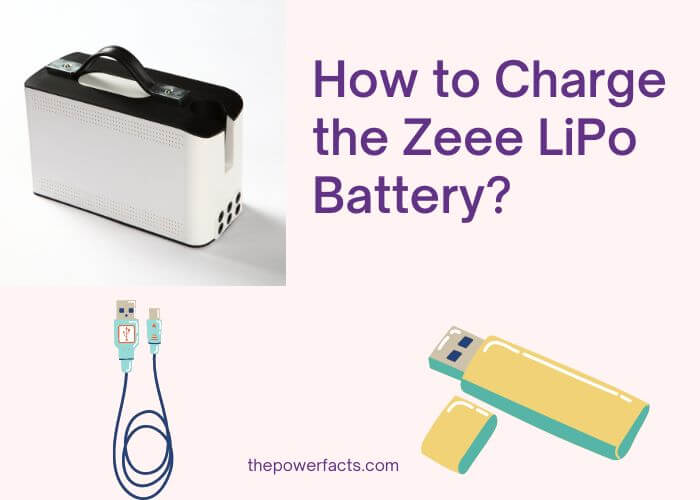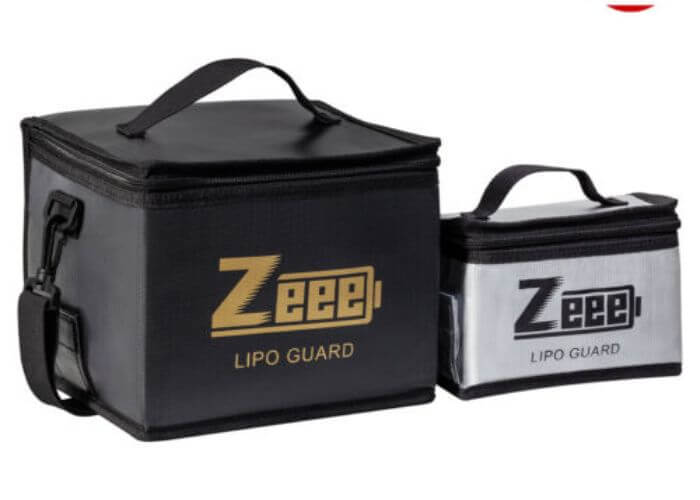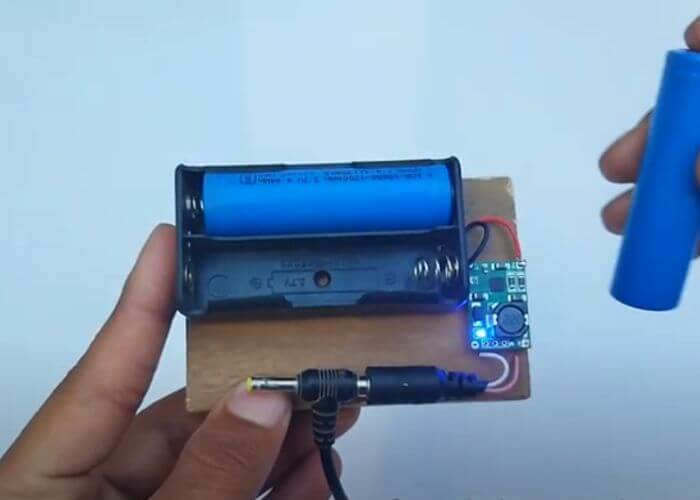The Zeee LiPo battery is a high-performance, rechargeable battery that can be used in various electronic devices. It is important to properly charge the battery before using it to get the best performance and longevity out of the battery.

There are a few things to remember when charging the Zeee LiPo Battery:
- Plug the LiPo battery into the charger;
- Ensure the charger is set to the correct voltage for the Lipo battery;
- Connect the charger to a power source;
- The charger will now start charging the LiPo battery;
How Do You Charge a LiPo Battery for the First Time?
Remember a few things when charging a Lipo battery for the first time:
Use the Correct Charger
Make sure you use the correct charger for your battery. Two main chargers are available for LiPo batteries: DC (direct current) and CC/CV (constant current / constant voltage).
DC chargers are typically less expensive than CC/CV chargers, but they do not offer as much protection against overcharging or excessive heat build-up during charging. So if you can afford it, we recommend using a CC/CV charger.
Maximum Charge Voltage and Current
Second, be aware of your particular battery’s maximum charge voltage and current. Be aware of your particular battery’s maximum charge voltage and current. Each LiPo battery has a different maximum voltage and current rating.
For example, some 3S 11.1V 5000mAh batteries can be charged at up to 4A (4400mAh), while others can only handle 2A (2200mAh). If you try to charge your battery at too high a rate, you risk damaging or even destroying the cell(s). So always check the specs on your particular battery before charging it! We have a detailed article on voltage charts; click here to read it.
Balance the Charge
Always balance and charge your LiPo batteries. Balance charging is when you charge each individual cell in a multi-cell pack (like a 3S 11.1V 5000mAh pack) separately to reach the same final voltage level—usually 4.2V per cell. This ensures that every cell in the pack is evenly used during discharge and helps prolong the overall life of the pack.
Many modern LiPo chargers have built-in balancing functionality. Still, if yours doesn’t, you’ll need to purchase a separate balancing board or use an adapter cable with an external balancer.
Don’t Overcharge
Never overcharge your batteries! This one is important: Always remove LiPos from the charger once they’ve reached 4 . 2 V per cell, and never let them sit on the charger unattended for extended periods of time. Overcharging not only reduces the lifespan of your LiPos, but it can also be dangerous—excessive heat buildup inside a LiPo can lead to fires or explosions.
How Do I Charge My LiPo Battery?

When it comes to charging a lithium polymer (LiPo) battery, there are a few things that you need to take into account:
| Number one | The first is the battery’s voltage, which must match the charger’s voltage. |
| Number two | Second is the battery’s capacity, which will determine how long it takes to charge. |
| Number three | You need to ensure that the charger is compatible with LiPo batteries. If you’re using a standard LiPo battery, it will have a voltage of 3.7 volts. Most chargers will be able to accommodate this voltage, but it’s always best to check before plugging anything in. |
| Number four | You’ll also need to consider the capacity of your battery, which is measured in milliamp hours (mAh). This will determine how long it takes to charge your battery; for example, a 1000mAh battery will take one hour to charge on a 1A charger. |
Once you’ve determined all this, you can simply plug your charger into your LiPo battery and let it do its thing.
Just be sure not to overcharge your battery; most chargers will shut off automatically when the voltage reaches 4.2 volts per cell, but it’s still good practice to keep an eye on things just in case. If you want to learn more about where LiPo batteries are used, read the article here.
How Many Amps Should I Charge My 5000Mah LiPo?
Assuming you are talking about a 3S 5000mAh LiPo battery, you should charge it at around 5 amps. This will give you a good balance between charging time and efficiency.
How Do You Charge a 7.4 V Lithium Ion Battery?

Lithium-ion batteries are one of the most popular batteries on the market today. They are used in many electronic devices, including cell phones and laptops. Many believe lithium-ion batteries are difficult to charge, but this is not true.
Charging a 7.4 V lithium-ion battery is a very simple process:
| First Step | The first step is to locate the battery charger. Most chargers for this type of battery will have a standard USB port. If you do not have a charger with a USB port, you can purchase one at any electronics store. If you want to learn more details about battery chargers, read here. |
| Second step | Once you have located the charger, plug it into an outlet and connect the other end to the battery. |
| Third step | Once the charger is connected to the outlet and the battery, it is time to begin charging it. |
| Final step | The process is very straightforward – simply press the “charge” button on the charger and wait for the light to turn green. This indicates that the battery is fully charged and ready to use. If you want to charge your 7.4 V lithium-ion battery more quickly, you can do a few things. |
Note
One option is to use a higher voltage charger; however, this may slightly shorten your battery’s lifespan, so it is not recommended unless you are in a hurry.
How to Charge 2S LiPo Battery?
When it comes to charging a 2S LiPo battery, there are a few things that you need to keep in mind:
- First and foremost, you must ensure you are using the correct charger. This is especially important if you use a balance charger, as using the wrong charger can damage your battery.
- Once you have the proper charger, the next thing that you need to do is connect it to your battery.
- If you use a balance charger, you will need to connect the positive and negative wires from the charger to the corresponding ports on your battery. Once everything is connected, turn on your charger and let it do its job.
It is important to note that when charging a LiPo battery, you should never leave it unattended. Not only could something go wrong with the charger, but there is also always the potential for fire hazards. So, stay close by and watch things while your battery is charging.
These simple tips will help ensure that you charge your 2S LiPo battery safely and correctly every time.
How to Charge a LiPo Battery Without a Charger?
LiPo batteries are an excellent option for R/C enthusiasts because they offer high power and discharge rates. However, one downside to LiPo batteries is that they require a special charger. If you’re out on the field and your battery dies, this can be an issue.
Fortunately, there are ways to charge a LiPo battery without a charger:
Use 12V Power Supply
One way to do this is by using a 12V power supply and connecting it directly to the battery leads. This will charge the battery, but it won’t be as fast as using a proper charger.
Use Balance Corrector
Another way to charge a LiPo battery is by using a balance connector. This method is slower than a power supply but much safer. You can always use an old cell phone charger if you don’t have access to any of these methods.
Just connect the positive lead of the charger to the positive lead of the battery, and connect the charger’s negative lead to the battery. This method will work, but it will take longer to charge your battery.
Li-Po Battery Charging Tips
When it comes to charging your Li-Po battery, there are a few things you need to keep in mind to do it safely and correctly.
Here are some tips to help you get the most out of your battery:
| Use the right charger | Make sure you’re using a charger specifically designed for Li-po batteries. Using the wrong type of charger can damage your battery or even cause a fire. |
| Balance charge if possible | If your charger has the ability to balance charge, it’s best to use this feature. Balancing charging ensures that all cells in the battery are evenly charged, which prolongs the battery’s life and helps prevent issues like cell imbalance (which can lead to decreased performance and capacity over time). |
| Don’t overcharge | When charging your Li-Po battery, do not exceed 4.2V per cell. Overcharging can damage the cells and shorten the overall life of the battery. |
| Store at the proper voltage | Once fully charged, store your Li-Po battery at 3.8V per cell (50% charge). Storing at total capacity can decrease the lifespan of your battery, so it’s best to err on the side of caution and store at 50%. |
How to Charge LiPo Battery?
How to Charge LiPo Battery Most of the time, you can charge your LiPo battery with a standard charger for other batteries.
However, there are some things that you need to keep in mind when charging a LiPo battery:
- First, ensure that the charger is set to the correct voltage.
- Second, you need to be careful not to overcharge the battery.
- Finally, you should always check the battery’s temperature during charging and ensure it does not get too hot.
If you follow these simple guidelines, charging your LiPo battery will be a breeze!
How to Charge 7.4V LiPo Battery?
When it comes to charging your 7.4V LiPo battery, there are a few things you need to keep in mind:
Use Right Charger
First, make sure you have the right charger for the job. You don’t want to use a NiCd or NiMH charger, which could damage your battery.
Check the Voltage
Second, always check the voltage of your battery before you start charging it. This will help ensure that you don’t overcharge it and cause damage. To charge your 7.4V LiPo battery, connect it to your charger using the appropriate adapter.
- Then set the charger to the correct voltage (7.4V) and current (usually 1-2A). Once everything is hooked up, press the “charge” button on your charger and wait for the process to complete. Depending on the size of your battery, this could take anywhere from 30 minutes to several hours.
- Once your 7.4V LiPo battery is fully charged, disconnect it from the charger and store it in a safe place until you’re ready to use it again. Never leave a LiPo battery unattended while charging – if something goes wrong, it could catch fire or explode!
How to Charge a 5200Mah LiPo Battery?
Like most people, you probably use a 5200mAh LiPo battery to power your electronic devices. But what do you do when it’s time to charge your 5200mAh LiPo battery?
Here’s a quick guide on how to charge a 5200mAh LiPo battery:
| Step one | First, make sure that your charger is compatible with the voltage and capacity of your 5200mAh LiPo battery. Many chargers have settings for different types of batteries, so be sure to select the correct settings for your specific battery. |
| Step two | Once you’ve confirmed that your charger is compatible, simply connect the positive and negative terminals to the corresponding terminals on your 5200mAh LiPo battery. |
| Step three | Next, set the current output of your charger according to the manufacturer’s recommendations. Once again, this will vary depending on your charger and battery. Still, as a general rule of thumb, it’s best to start out with a lower current setting and increase it gradually until the desired charging rate is reached. |
| Step four | Finally, begin charging your 5200mAh LiPo battery by plugging in the AC adapter or connecting it to another power source. |
Most chargers will have an LED indicator that will let you know when charging is complete; however, it’s always best to check the voltage of your battery with a voltmeter just to be sure. That’s all there is to it! Follow these simple steps, and you’ll have no trouble keeping your 5200mAh LiPo battery charged and ready to go.
LiPo Charge Rate Calculator
Do you know what your LiPo battery’s charge rate should be? If not, you can use our LiPo Charge Rate Calculator to find out! Enter your battery’s capacity and voltage, and the calculator will do the rest.
Why is the charge rate important? Your battery’s charge rate determines how fast it can be safely charged. While you may be tempted to charge your battery as quickly as possible, doing so can shorten its lifespan.
Therefore, choosing a charge rate that balances speed with longevity is essential. How does the LiPo Charge Rate Calculator work? The calculator uses a simple formula to determine your battery’s maximum safe charge rate.
- First, it divides your battery’s capacity (in mAh) by 1,000. This gives you the number of amps your battery can safely handle. Next, the calculator takes your battery’s voltage (in volts) and divides it by 4.
- This gives you the hours it would take to charge your battery at its maximum safe rate safely.
- Finally, the calculator multiplies these two numbers to give you your maximum safe charge rate in amps. For example, let’s say you have a 2200mAh 7.4V LiPo battery.
Using the formula above, we can calculate that this battery has a maximum safe charge rate of 2200mAh / 1000 = 2.2A 7.4V / 4 = 1.85 hours * 2.2A = 4 amps.
So, this LiPo could be charged at up to 4 amps without significantly damaging or reducing its lifespan.
How to Charge LiPo Batteries With Balance?
Balance charging charges for each cell in a lithium polymer (LiPo) battery to the same voltage. This is done by monitoring the voltage of each cell during the charge and stopping when they are all equal. Most LiPo batteries have a balance connector that allows you to plug into a balance charger.
This will ensure that all cells are charged evenly and prevent overcharging and damaging the cells.
Suppose your LiPo battery doesn’t have a balance connector. In that case, you can still charge it with a regular charger by connecting the positive lead to the positive terminal of each cell and the negative lead to the negative terminal of each cell.
However, you’ll need to keep an eye on the voltages of each cell during the charge so that you don’t overcharge them.
Here’s a quick overview of how to balance charge a LiPo battery:
1. Connect your balance charger to the power source and your LiPo battery to the charger.
2. Select the appropriate charge rate for your battery according to its capacity (mAh). Most chargers have options for 1c, 2c, 3c, etc., which refer to how many times faster than one hour it will take to charge your battery. For example, if you select 2c on a 1000mAh battery, it will take 30 minutes to charge instead of 60 minutes.
3. Once connected, most chargers will start automatically charging your LiPo battery at whatever rate you selected in step 2 until it’s fully charged or until you stop it manually.
Some chargers may require you to press a button to start charging.
Conclusion
To charge the Zeee LiPo Battery, you will need a LiPo balance charger. You should use a charger with a maximum charge rate of 2C. If your battery is 4000mAh, then you should charge it at 8A.
Relevant Resources: